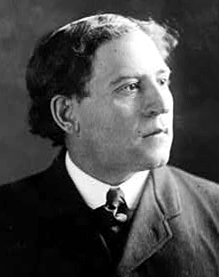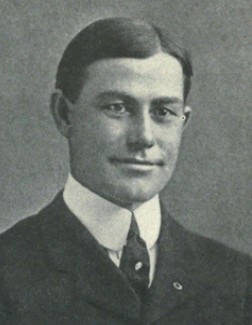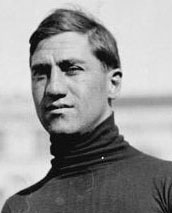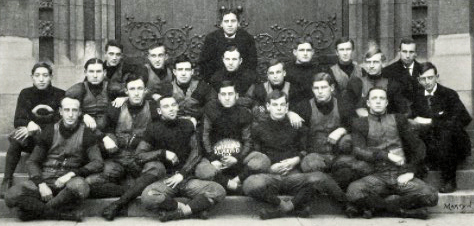Clash of Titans
Games featuring a future Hall of Fame coach on each sideline.
November 10, 1906: Minnesota @ Chicago
Henry Williams vs Amos Alonzo Stagg
The winds of change blew through college football after the 1905 season. The hurricane started in the Big Nine Conference (formerly the Western Conference) in January and continued to the national football rules committee in April. College faculties in the Northeast and Midwest had become increasingly dissatisfied with the brutality of football and the dilution of the concept of "student-athlete."
Representatives from the Big Nine schools agreed on eight provisions. These were the ones that caused the most consternation.
- That athletic eligibility be reduced from four years to three and be limited to undergraduates.
- That the football season be limited to five games.
- That students be required to pass all university entrance requirements, all intervening school work, and take a full class load in the present semester.
- That "hereafter there shall be no coaching except by regular members of the instructional staff ... and that the salary attaching to the position shall be no more than that paid to other members of the faculty of the same rank."
The last rule proved to be the most controversial. Chicago's Amos Alonzo Stagg and Minnesota's Henry Williams were the only two conference coaches who satisfied the requirement. Fielding Yost at Michigan and the other six football coaches would be banned. The contentious relationship of Michigan and Chicago grew more toxic as Michigan supporters suspected (erroneously) that Stagg was behind the new rule.
Stagg's title, as listed in the Chicago yearbook for 1907, was "Professor and Director of Physical Culture and Athletics."
Blowback against several of the proposals led to a second meeting of the faculty reps that amended the coaching rule to merely "recommend" that only faculty members serve as coaches "as soon as existing contracts ... permit."
The committee's other change exempted 1906 seniors from the three-year rule. The most outstanding player who benefited from that revision was Chicago QB Walter Eckersall.




L-R: Amos Alonzo Stagg, Henry Williams, Fielding Yost, Walter Eckersall
The national rules committee passed multiple rules that drastically changed football.
- Forward passes were made legal but with restrictions. An incompletion drew a 15y penalty. Also, a pass could not be caught more than 20y beyond the line of scrimmage nor beyond the goal line.
- Tackles and guards could no longer drop into the backfield. This change was meant to eliminate "mass formations" such as the "flying wedge" in which the offense locked hands in a V-shaped pattern and mowed down defenders in their path.
- Halves were reduced from 35 minutes to 30.
- A neutral zone the length of the ball would separate the two teams at the line of scrimmage.
- A team had to gain 10 yards in three downs for a first down rather than five yards. Fields would have lines every five yards instead of every ten.

1906 Chicago Maroons football team
Stagg and Williams had been teammates at Yale under legendary coach Walter Camp. Stagg became Chicago's head coach in 1892 while Williams, after earning an M.D. degree, came to Minnesota in 1900. Their teams had met only once, playing a 6-6 tie in Williams' first year in charge of the Gophers. While rivals in the Big 9, Stagg and Williams were united in their animosity toward Fielding Yost.
Because their stadium, Marshall Field, was the largest in the conference, Chicago hosted all five of its 1906 Big 9 opponents. They easily disposed of Purdue (39-0) and Indiana (33-8) before the Gophers came to the Windy City.
Meanwhile, Minnesota won their first two games at home: Iowa State 22-4 and Nebraska 13-0. Coach Stagg left his assistants to coach the Indiana game while he journeyed to Minneapolis "to see what Doc Williams had up his sleeve and came back with reports that it was a Royal Flush. But Nebraska had held the Gophers down to a 13-0 score the week before, and Nebraska had been defeated by Ames. That gave the (Chicago) rooters a basis upon which to figure out a victory and they all felt confident of the result." (University of Chicago Cap and Gown Yearbook Class of 1907)
"The biggest western football game of the season" (as declared by the Rockford IL Daily Register-Gazette) was considered to be a contest between Chicago's "lightning-like speed" and Minnesota's "weight and veterans." Gopher LT William Ittner was 6'3" 234lbs and LG Theodore Vita, 6'2" 211. On the right side, George Oech and George Case stood under 6' tall but weighed 215 and 222 respectively.
At the banquet the night before the game, Stagg admitted that he was concerned about Williams' "ability as a football strategist" and was afraid of him.
But Minnesota's biggest advantage may have been the weather. A drizzling rain throughout the game that made the field soggy and the ball slippery blunted the Maroons' speed advantage.

1906 Minnesota Gophers football team (University of Minnesota Gopher Yearbook Class of 1907)
Robert Marshall is sitting at the far left of the first row.
Scoreless First Half
The first half showcased the two punters, Eckersall for Chicago and Arthur Larkin for Minnesota with Eckersall having the advantage. "High and far he kicked, and Chicago ends were always down field, but Larkin and other Minnesota backs seldom fumbled he ball and never let it get away from them."
To illustrate the cotnservative strategy of both teams, Larkin booted the sixth punt of the game to Walter Seffen, who returned the ball to midfield to give the Maroons the best field position for either side to that point. But after one running play, Eckersall punted. Three plays later, Eckersall returned the ball to Minnesota's 45 – even better field position. But the Maroons again could not take advantage.
Later in the half, the Gophers finally moved into enemy territory. On third down, Robert Marshall tried a place kick, but the ball sailed wide of the posts.
In the final minutes of the half, Ittner broke away around Chicago's right end for a gain of 30y to the Chicago 30. That led to another field goal try, but the oval again flew to one side, and the first half ended 0-0.
Gophers Finally Score
Minnesota's giant line gradually wore down the lighter Chicago defenders in the second half until the Gophers finally broke the scoring ice. Archibald Robertson broke through left tackle into the clear, and only a pretty tackle by Eckersall prevented a touchdown after a 26y gain to the Chicago 30. That led to Marshall's field goal from placement to make it 4-0 Minnesota.
Marshall was the first Black letter winner in the Big 9 Conference.
Late in the second half, with Minnesota not making a substitution the entire game, Chicago cut the lead in half with a safety. The score was set up by Eckersall's long punt to the two. With the Maroons' speedy ends on top of him, Larkin caught the ball, stepped back behind his goal line, and touched the ball down for a safety. That allowed Larkin to punt from the 25 into Chicago territory.
FINAL SCORE: MINNESOTA 4 CHICAGO 2
FINAL SCORE: MINNESOTA 4 CHICAGO 2
"Then ensued a typical Minnesota celebration. The team started it by throwing sweaters and headgear into the air. The Minnesota rooters and spectators swarmed off the stands and despite the pelting rain, threw hats in the air and embraced."
The Big 9 leaders realized they had gone too far with their "reforms" and allowed teams to play seven football games each year starting in 1908.
References:
Stagg vs Yost: The Birth of Cutthroat Football, John Kryk (2015)
Stagg vs Yost: The Birth of Cutthroat Football, John Kryk (2015)